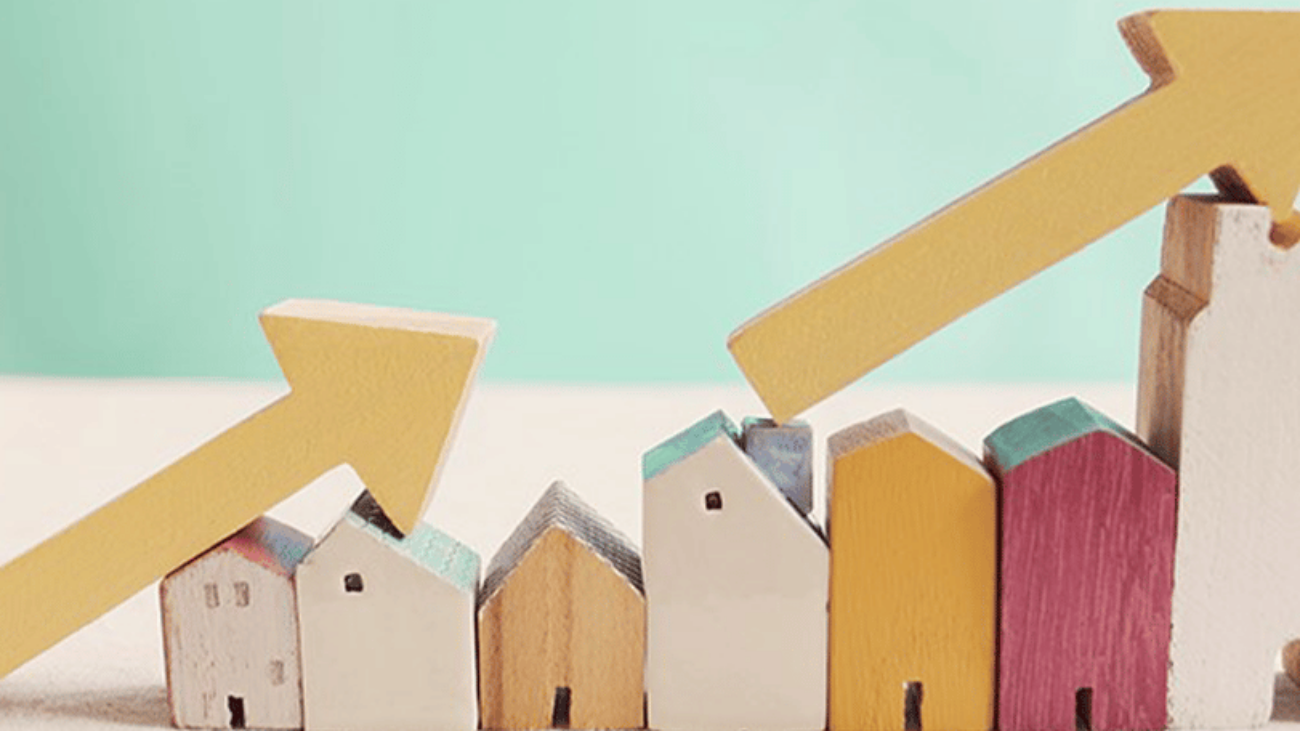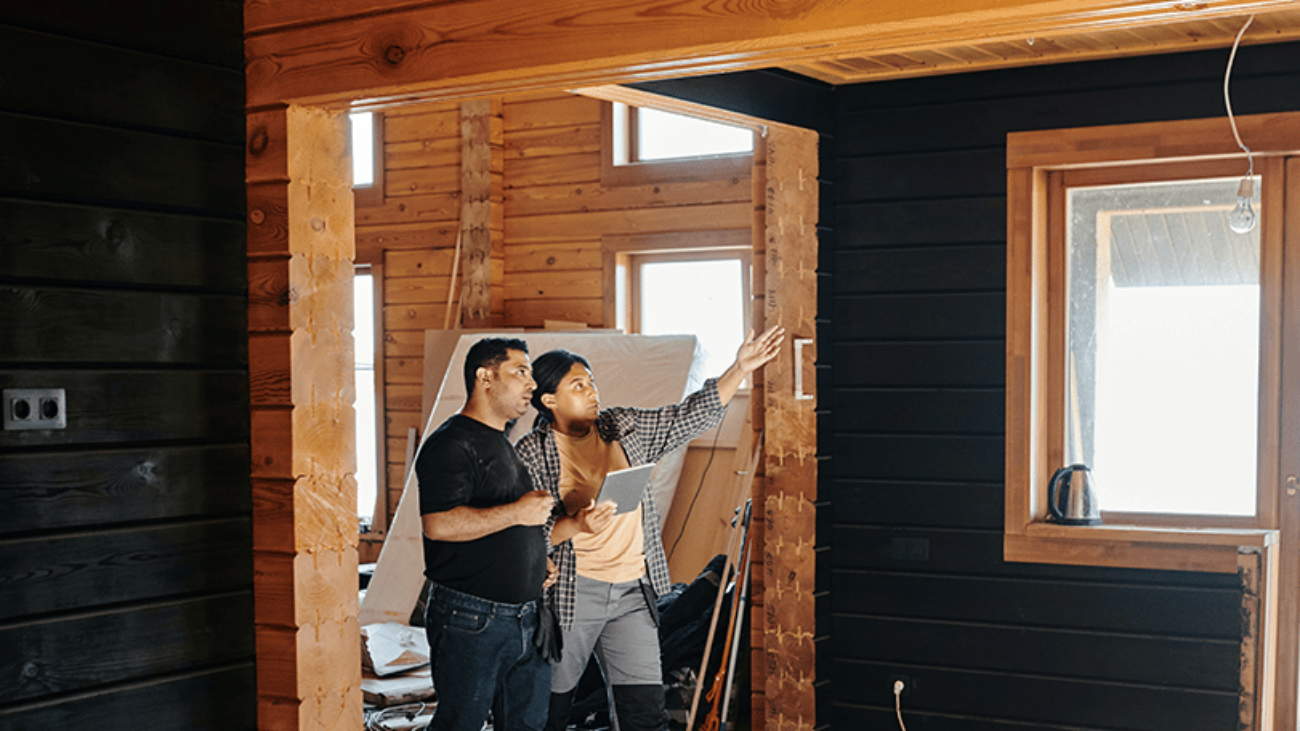Spend your time on tasks that make it feel inviting, show it’s cared for, and boost your curb appeal. To determine the full list of things you’ll want to tackle for your home, you need the opinion of a trusted expert. Let’s connect to help make sure your house shows well this season.
[/et_pb_text][/et_pb_column][/et_pb_row][/et_pb_section]The Future of Home Price Appreciation and What It Means for You
Many consumers are wondering what will happen with home values over the next few years. Some are concerned that the recent run-up in home prices will lead to a situation similar to the housing crash 15 years ago.
However, experts say the market is totally different today. For example, Odeta Kushi, Deputy Chief Economist at First American, tweeted just last week on this issue:
“. . . We do need price appreciation to slow today (it’s not sustainable over the long run) but high price growth today is supported by fundamentals- short supply, lower rates & demographic demand. And we are in a much different & safer space: better credit quality, low DTI [Debt-To-Income] & tons of equity. Hence, a crash in prices is very unlikely.”
Price appreciation will slow from the double-digit levels the market has seen over the last two years. However, experts believe home values will not depreciate (where a home would lose value).
To this point, Pulsenomics just released the latest Home Price Expectation Survey – a survey of a national panel of over 100 economists, real estate experts, and investment and market strategists. It forecasts home prices will continue appreciating over the next five years. Below are the expected year-over-year rates of home price appreciation based on the average of all 100+ projections:
- 2022: 9%
- 2023: 4.74%
- 2024: 3.67%
- 2025: 3.41%
- 2026: 3.57%
Those responding to the survey believe home price appreciation will still be relatively high this year (though half of what it was last year), and then return to more normal levels over the next four years.
What Does This Mean for You as a Buyer?
With a limited supply of homes available for sale and both prices and mortgage rates increasing, it can be a challenging market to navigate as a buyer. But buying a home sooner rather than later does have its benefits. If you wait to buy, you’ll pay more in the future. However, if you buy now, you’ll actually be in the position to make future price increases work for you. Once you buy, those rising home prices will help you build your home’s value, and by extension, your own household wealth through home equity.
As an example, let’s assume you purchased a $360,000 home in January of this year (the median price according to the National Association of Realtors rounded up to the nearest $10K). If you factor in the forecast for appreciation from the Home Price Expectation Survey, you could accumulate over $96,000 in household wealth over the next five years (see graph below):
[/et_pb_text][et_pb_image src=”https://carolinedinsmore.com/wp-content/uploads/2022/04/GRAPH.png” title_text=”GRAPH” _builder_version=”4.14.8″ _module_preset=”default” global_colors_info=”{}”][/et_pb_image][/et_pb_column][/et_pb_row][et_pb_row _builder_version=”4.14.8″ _module_preset=”default” global_colors_info=”{}”][et_pb_column type=”4_4″ _builder_version=”4.14.8″ _module_preset=”default” global_colors_info=”{}”][et_pb_text _builder_version=”4.14.8″ _module_preset=”default” global_colors_info=”{}”]Bottom Line
If you’re trying to decide whether to buy now or wait, the key is knowing what’s expected to happen with home prices. Experts say prices will continue to climb in the years ahead, just at a slower pace. So, if you’re ready to buy, doing so now may be your best bet for your wallet. It’ll also give you the chance to use the future home price appreciation to build your own net worth through rising equity. If you want to get started, let’s connect today.
[/et_pb_text][/et_pb_column][/et_pb_row][/et_pb_section]Housing Perspective: Why 2022 Might Still be the Right Time to Buy
In addition to an extremely tight housing market in California, prospective homebuyers are also now facing the prospect of a rising cost of living on everything from cars to gas to groceries to consumer goods. This, in turn, has triggered a more aggressive stance by the Federal Reserve, which has signaled that they are prepared to raise their target interest rate several times this year in order to stave off further inflation. Thus far, interest rates for 30-year, fixed-rate mortgages have already risen from an all-time low of 2.65% at the beginning of 2021 to nearly 4% by February 2022. In addition, the emerging conflict between Russia and the Ukraine threatens additional inflation in the U.S. as global oil supplies are disrupted.
However, despite the rising headwinds facing the real estate market in California, there are also reasons for potential homebuyers to overcome the dreaded “buyer fatigue” to get their foot on the property ladder in 2022. First, interest rates are expected to continue to normalize back to pre-pandemic levels where rates above 4% were the rule, not the exception. Even if the Federal Reserve does not raise rates as many times as they have signaled, inflation expectations and a recovering economy will translates into higher long-term rates—the question is simply, “by how much?” This is an important consideration for future homebuyers because for the projected $830,000 median-priced home in California this year, each 0.5% increase in mortgage rates translates into roughly $200 per month in additional mortgage payments. And, that additional payment is for the same exact $830,000 home. No extra square footage; no extra amenities; no extra outdoor space—$200 per month is simply additional borrowing costs.
Another important factor for homebuyers to consider is the outlook for home prices. Even with the rise in interest rates, housing demand still far outstrips housing supply in California and this trend is expected to generate more upward pressure on home prices. Despite the turbulent economic environment owing to the pandemic, the fundamentals in the housing market remain robust and the prospects for a surge of defaults and foreclosures driving a flood of new inventory onto the market are minimal as a result. C.A.R. is currently forecasting that the median home price will rise by 5.2% in 2022, but there is consensus amongst other forecasters that prices will continue to rise as well.
Taken together, that means that the cost of waiting until next year will be two-fold: paying higher prices at even higher interest rates—something that will have significant financial implications for homeowners over a 30-year loan period.
Finally, the white-hot market characterized by extreme competition amongst buyers that prevailed last summer, has ebbed slightly creating a bigger window of opportunity for would-be homeowners. Although still very tight by historical standards, homes are staying on the market slightly longer now than they were in 2021. In addition, the percentage of homes selling for more than the asking price has also fallen slightly—another positive development for those submitting offers. As always, the decision on when is the “best time to buy” a home comes down to the individual personal and financial circumstance. However, an improving economy, rates that are still near historic lows, and the prospect of both higher prices and higher interest rates in the future suggest that, for those in a position to be able to do so, 2022 could be a good time for many homebuyers to finally achieve the American Dream of homeownership.
COPYRIGHT © CALIFORNIA ASSOCIATION OF REALTORS®
[/et_pb_text][/et_pb_column][/et_pb_row][/et_pb_section]7 Time-Sucking Remodeling Mistakes You’ll Wish You Could Erase
[et_pb_section fb_built=”1″ _builder_version=”4.9.4″ _module_preset=”default” global_colors_info=”{}”][et_pb_row _builder_version=”4.9.4″ _module_preset=”default” global_colors_info=”{}”][et_pb_column type=”4_4″ _builder_version=”4.9.4″ _module_preset=”default” global_colors_info=”{}”][et_pb_text _builder_version=”4.9.4″ _module_preset=”default” global_colors_info=”{}”]
It may see counterintuitive, but a rigid schedule can really mess things up.
One of the things that drives up remodeling costs (and frustration levels!) are delays. And these delays are often caused by ignorance on the homeowner’s part.
It’s that old axiom: You don’t know what you don’t know.
Until now.
Here’s a list of time-sucking mistakes homeowners often make (so you don’t have to).
#1 Designing Before Budgeting
You think you can afford that luxurious marble countertop — until you talk to the fabricator. It’s $2,000 over budget, and there’s no room to squeeze. If you’re already past the design phase, that’s a brutal discovery requiring a serious re-think — and extra time you don’t have at this stage of the game.
“There are an infinite number of design possibilities, but as soon as you pick a budget, seven-eighths are gone,” says Charles Rinek, who owns a remodeling and custom construction firm in Palm Coast, Fla. “Concentrate on the eighth that is appropriate with your budget.”
Know your budget. Then follow your dreams.
#2 Indecision
Even the design-challenged can create a stunning kitchen with Pinterest on their side. But the breadth of options might create dismay — and delay — if you keep finding a better backsplash.
“Over-analysis becomes paralysis,” says Annmarie Bhola, who co-owned a remodeling company. “Now you spend all this time watching shows, and looking through Pinterest, and before you know it, oh my gosh, now I have all this data. Which should I choose? Should I go with light or dark?”
And then, the paint color isn’t right. So now you’ve got to rethink your complete color scheme.
Don’t be that homeowner. Once your design is finalized and construction is under way, consider your choices set in stone, or you might find yourself days, even weeks behind schedule when workers are waiting on you to decide.
#3 Scheduling Work Before Materials Are On Site
You might have allotted enough time for each step — but if what you need isn’t there when you need it, all the scheduling in the world isn’t going to make up for that lost time.
Before scheduling workers to install your new cabinets and appliances, make sure the materials will be there for them. Don’t just allocate installation time; know how long it will take to ship your farmhouse sink. (Another related point: Know your contractor’s schedule, too, so you won’t be dismayed when he can’t come the day your cabinets arrive.)
Bhola says her common practice is to order everything ahead of time, to know the delivery dates, then to schedule contractors to start after that date.
Time is almost always the reason why kitchen remodeling mistakes happen.
#4 Choosing to Live in the Mess
Remodeling is messy — dust everywhere, your pots and pans scattered, and living spaces become storage spaces.
No one expects you to be Martha in the midst of a home makeover, but too much disorganization will hog your time because you can’t find anything. Next thing you know, you’re a day behind because you couldn’t find the installation guide for the dishwasher.
As part of your project plan, include a strategy for a temporary kitchen and all the stuff that needs a new home while construction is happening. And be sure to plan time to move it all so a) you don’t end up dumping everything in the nearest clear spot, or b) delaying the start of demolition, which means you’ll be starting out with a #fail.
#5 Not Paying Attention to Permits
Your Uncle Joe swore he didn’t pull a permit for his kitchen remodel, and everything turned out fine. But if an inspector raises an eyebrow on a drive around the ‘hood, skipping this essential step could cost you months of inspections and repairs.
Give your local building department a heads-up. Plus, permits ensure your renovation is to code, catching any dangerous (or deadly) errors, like faulty outlets and improper plumbing.
Just make sure to budget time for the inspection.
“You can’t move forward with anything until it’s been inspected,” Rinek says. “God forbid he doesn’t show up until 4 p.m. and he doesn’t like your work. All that time adds up.”
#6 Not Doing a Test Run on Materials
That soft coral tone was sure to make your subway tile pop. Until it didn’t. Give every paint, tile, and wood type a test run, otherwise, you might find yourself not liking the results, and then find yourself falling behind schedule while you pick the replacements.
For paint, Harris recommends covering a few inexpensive canvases in your favorite colors and leaving them in the room for a few days to help you decide. Do this long before workers come on site. As for cabinets, he suggests you “get a whole door.” You can’t see what a cabinet “really looks like from a three-by-three sample.”
#7 A Too-Rigid Schedule
It might seem counterintuitive, but sometimes, your best choice is to just suck it up and cause a delay — especially if you don’t want regrets later.
“Time is almost always the reason why kitchen remodeling mistakes happen,” says Evan Harris, a San Diego real estate investor.
If you do start falling behind schedule because of unexpected surprises (darn carpenter bees — on top of hurricane weather, really?!), you might be tempted to try and make up the time.
But there’s where the danger lies, says Harris. That’s when you end up with sloppy work that may not stand the test of time: cabinets that aren’t level, a floor that wasn’t allowed to dry completely between coats and loses its luster too soon, a sloppy paint job. Cue future problems and expenses.
His advice: Budget even more time than you think you need for every step — and you might even finish early, in plenty of time to plan your housewarming.
By: Jamie Wiebe
Photo: Mikael Blomkvist
[/et_pb_text][/et_pb_column][/et_pb_row][/et_pb_section]
8 Trending Home Design Features for a 2022 Lifestyle
[et_pb_section fb_built=”1″ _builder_version=”4.9.4″ _module_preset=”default” global_colors_info=”{}”][et_pb_row _builder_version=”4.9.4″ _module_preset=”default” global_colors_info=”{}”][et_pb_column type=”4_4″ _builder_version=”4.9.4″ _module_preset=”default” global_colors_info=”{}”][et_pb_text _builder_version=”4.9.4″ _module_preset=”default” global_colors_info=”{}”]
There’s a lot to consider when selling your home, from the market and appraisals to where you’ll go next. Don’t forget, however, that design is also a key factor. It’s often one of the first things buyers notice when they walk into a home, and it’s also a detail that you, as a seller, can easily control.
According to Realtor.com’s 2022 housing market forecast, home for-sale inventory will increase from last year, as will the projected number of overall sales. This means, if you’re looking to sell in the near future, now is the time to consider how you can stand out.
Updating your home design is one way to do that. Changes like new security features or upgraded siding can add value to your home now and be highlighted when you market it for sale later. To get the most out of your updates, focus on these popular home design features that will wow buyers in 2022.
Keep in mind, not all of these will work well in every house. If you plan to buy, list, or renovate a property, give us a call. We can help you realize your vision and maximize the impact of your investment.
Eco-Friendly Fixtures
Millennials account for the largest share of current homebuyers, according to the National Association of Realtors. Sustainable living tops the list of priorities for this generation. A recent Deloitte survey found that nearly one-third of millennials initiate or deepen their consumer investment in products or services that help the environment—this also includes the houses they choose to live in.
Here are a few eco-friendly design features that will be attractive to these millennial buyers in 2022. Bonus, they can net a significant return on investment (ROI) for you, as a seller, too.
- Energy-Efficient Windows: Heat gain or loss from low-performance windows drives 25–30 percent of home heating and cooling costs, according to Energy.gov. Therefore, energy-efficient windows can help homeowners save money.
- Low-Flow Water Fixtures: According to the EPA, replacing your shower head with one that’s labeled with WaterSense can save four gallons of water with each shower. Doing the same with your faucet can save 700 gallons per year. This leads to cost savings and environmental support.
- Native Landscaping: According to the American Society of Landscape Architects, 58 percent of members report increased client demand for native trees and plants as a means to combat biodiversity loss from climate change. Enhance the eco-friendly appeal of your home with some native plants in the front yard.
Wellness Retreat Nooks
The pandemic has had a significant impact on mental health. For example, in an effort to prioritize mental health, many people are relocating to quieter, more peaceful homes, with 22 percent of city dwellers planning a move to less congested residential areas, according to the Home Improvement Research Institute’s (HIRI) 2021 Insights Summit.
However, no matter where you live, you can still intrigue buyers by jumping on this trend. At-home wellness amenities, which were once viewed as luxuries, are now on many homeowners’ must-have lists. Indoor spaces that function as a retreat for wellness and self-care have become extremely popular, according to HIRI.
Improve your quality of life in your home with reading nooks, spa-inspired bathrooms, and exercise or meditation spaces. Even if your house doesn’t have the square footage to section off an entire room for relaxation, making simple tweaks to natural light, air purifiers, and indoor plants can help you feel better in your home now while enabling future buyers to see the opportunity for their own space.
Calming Paint Colors
Paint colors that produce a calming atmosphere will also be a key selling point in 2022. Soft earth tones and natural hues will prevail this year, including various shades of blue, green, brown, and beige. Recent research suggests steering clear of trendy paint colors in favor of a more classic palette to bring the feel of nature indoors in a subtle and soothing way.
In fact, the same research found that buyers are often willing to pay an extra $4,698 for a house with a light blue bathroom or an extra $1,491 for a house with a dark blue bedroom. Another crowd-pleasing hue to refresh the walls with is BEHR’s 2022 paint color of the year, known as Breezeway.
This shade of green with silver undertones was created to mimic sea glass. As the BEHR website describes it, Breezeway “evokes feelings of coolness and peace, while representing a desire to move forward and discover newfound passions.”
Home Safety Features
Buyers want peace of mind more now than ever before. According to a 2021 survey from the American Institute of Architects, members report seeing an increase in the popularity of these home safety features:
- Emergency backup power generation
- Accommodations for multiple generations
- Wider accessible doorways and hallways
- Home security monitoring equipment
- Interior ramps and home elevator features
Consider how you can build home safety features like these into the design of your home to enhance your quality of life now and attract more buyers later. For example, you could install a backup generator in the garage and sell it with the house or update your major doorways to be wider.
Before making an investment in expensive home safety upgrades, contact us. We can help you determine what will deliver the greatest ROI for your location and goals.
Designated Work Spaces
It may come as no surprise that after the pandemic, 63 percent of homebuyers want their next house to feature room for a designated office, according to the National Association of Home Builders. In addition, 70 percent of these buyers want the office to be at least 100 square feet (or a 10×10 room).
If you can, consider turning a bedroom or a den into a work-from-home office. When designing the space, make it both functional and aesthetically pleasing. Position a desk near the window for natural light, install a bookshelf unit, arrange a few succulents on the work surface, and hang a few framed posters or a cork bulletin board on the wall. You want the space to foster productivity as well as be a place in your home you enjoy spending time.
When you get ready to sell, we can help you highlight your designated work space. Given the high demand for this design feature, it can help you interest more buyers and attract more competitive offers—if marketed creatively.
Luxury Kitchen Retouches
The kitchen has always been a main focal point of interior design, and that’s no different in 2022. Families will always need this space to come together in their own homes.
This year’s buyers want a kitchen with new upgrades and retouches, but you don’t have to renovate the entire kitchen to make an impact. If you’re not sure where to start, here are a few tips on how to create a kitchen that buyers will love without spending too much money on renovations:
- Repaint the kitchen, keeping the calm and nature-inspired colors in mind that are most popular right now. Taking a kitchen from dark to light by painting cabinets and walls can make all the difference.
- Update the hardware. These kitchen “accessories” stand out and add personality to an otherwise standard kitchen.
- Update light fixtures to bring in more light while also adding a fresh look and feel to the space.
Unique Accent Walls
In a recent interview with the National Association of Realtors, Brian Santos, the director of education for Fresh Coat Painters, explains that bold, unique accent walls are trendy right now. An accent wall gives a home character while maintaining the calming feel of natural- and neutral-colored walls.
Santos also explains that this is part of a design aesthetic that draws inspiration from the Roaring Twenties, and it’s likely to remain a sought-after home feature in 2022. Here are some bold colors to consider for your home’s accent walls:
- Solid black
- Jewel or metallic tones
- Textured wallpaper
- Painted ceilings
- Built-in shelves
If you’re planning to sell in the next year, talk to us before adding an accent wall. Depending on your target buyer, it may be a design feature that actually hurts your home’s value. We can run a free Comparative Market Analysis on your home to help you understand what would resell best in your neighborhood.
Exterior Siding Updates
A new exterior siding refresh is one of the most affordable renovation projects you can do to help increase a home’s resale value. The average cost is just $12 per square foot, but higher-end material options can push costs closer to $50 per square foot. What’s more, there are many siding materials available, from fiber-cement, brick, and wood to vinyl, metal, and stone.
While all these options can infuse the exterior with character and add curb appeal, fiber-cement and vinyl deliver the highest ROI. In fact, according to a 2021 Cost vs. Value Report, a vinyl siding replacement can boost resale value by $11,315 (68.3 percent cost recoup), and a fiber-cement siding replacement can boost resale value by $13,618 (69.4 percent cost recoup).
Give your home this simple, affordable, and attractive facelift before putting it on the market. If you’re not sure how to get started yourself, our team can connect you with a trusted vendor to guide you through the process.
Keep These Home Design Features on Your Radar in 2022
These design features can infuse personality into your home while helping to close the deal if you plan to sell in 2022. The average buyer knows just what they’re looking for in a space they plan to call home, so with some investment and foresight, you can give your house an edge over the competition—and boost resale value in the process.
However, you don’t need to make all these changes to attract more buyers. We can help you determine which design features you should add to your home by sharing insights and tips on how to maximize the return on your investment. We can also run a Comparative Market Analysis on your home to find out how it compares to others in the area, which will help us decide what changes need to be made. Don’t hesitate to contact us: we have a deep history of successful home renovations that deliver a return on investment for our clients.
Sources:
- Realtor –
https://www.realtor.com/research/2022-national-housing-forecast/ - National Association of Realtors –
https://www.nar.realtor/research-and-statistics/research-reports/home-buyer-and-seller-generational-trend - Energy.gov –
https://www.energy.gov/energysaver/update-or-replace-windows - EPA.gov –
https://www.epa.gov/watersense/about-watersense - American Society of Landscape Architects –
https://www.asla.org/NewsReleaseDetails.aspx?id=60427 - Home Improvement Research Institute –
https://www.hiri.org/blog/4-major-home-wellness-trends-from-hiri-summit-speaker-dr-jie-zhao - Zillow –
http://zillow.mediaroom.com/2021-07-15-Homes-With-Light-Blue-Bathrooms,-Dark-Blue-Bedrooms-Could-Sell-for-Up-to-4,698-More-Than-Expected - Behr –
https://www.behr.com/colorfullybehr/behr-announces-2022-color-of-the-year-and-trends-palette/ - American Institute of Architects –
http://info.aia.org/AIArchitect/2021/0910/aia-interactive/index.html# - National Association of Home Builders –
https://www.nahb.org/-/media/NAHB/news-and-economics/docs/housing-economics-plus/special-studies/2021/special-study-what-home-buyers-really-want-march-2021.pdf?_ga=2.188050984.1824982414.1639512139-1247360189.1639512139 - National Association of Realtors –
https://www.nar.realtor/blogs/styled-staged-sold/hot-home-trend-the-accent-wall-is-back - Forbes –
https://www.forbes.com/advisor/home-improvement/how-much-does-siding-cost-to-install/ - Remodeling Magazine –
https://www.remodeling.hw.net/cost-vs-value/2021/
[/et_pb_text][/et_pb_column][/et_pb_row][/et_pb_section]
INVENTORY INSIGHTS
[et_pb_section fb_built=”1″ _builder_version=”4.9.4″ _module_preset=”default”][et_pb_row _builder_version=”4.9.4″ _module_preset=”default”][et_pb_column type=”4_4″ _builder_version=”4.9.4″ _module_preset=”default”][et_pb_text _builder_version=”4.9.4″ _module_preset=”default”]
The vast majority of agents around the country – and their buyers – are bemoaning the limited inventory of homes to buy. The reasons for this are many including:
1. The US has been under-building by millions for over a decade.
2. Most builders have focused more of their efforts on more expensive, more profitable homes.
3. Tons of Cheap money – and borrowing – has allowed people to pay more and fuel excessive price escalation in areas causing huge demand.
4. Institutional investors and i-buyers are competing with ‘regular’ home buyers further depleting inventory.
5. Wealthier buyers buying multiple homes. One person owning 3 homes equates to two fewer homes for other buyers to buy.
6. COVID-fueled migration from more expensive areas to cheaper areas of the US has driven prices up in those areas with increased demand AND buyers comfortable paying much more than locals.
7. Vast new wealth created from rapidly rising equity markets, crypto speculation, IPO’s, new business creation, inheritance, wealth transfer, etc has created a huge new pool of buyers, many armed with cash.
8. The COVID fueled desire to nest and own a home has unleashed the largest buying audience – millennials – to buy instead of rent after years of holding back.
9. Empty nesters seeking smaller homes are competing with first time buyers for smaller homes.
10. COVID fueled a greater awareness of our mortality fueling the desire to get on with life.
In some areas the inventory ‘on the market’ is very low. But there is quite a bit of inventory trading that barely makes it to market – if at all – because it is sold before it comes to market. That inventory is not registering clearly. Off-market deals are growing and they are mostly not pocket listings. The vast majority of these deals trade with both a buyer and seller agent.
It is for this reason – now more than ever before – for eager buyers to work with a professional, connected agent who knows inventory and the agents in their community extremely well. Betty Broker who knows Adam Agent well can help buyers achieve their goals now more than ever.
The Dinsmore Group would like to give content and writing credit to Leonard Steinberg @theleonardsteinbergteam. He shares his valuable insights through his wonderful Compass wide journal, Compass Contemplations. Mr. Steinberg holds the esteemed title of Chief Evangelist at Compass.
[/et_pb_text][/et_pb_column][/et_pb_row][/et_pb_section]
What Could Be GOOD About Rising Interest Rates?
[et_pb_section fb_built=”1″ _builder_version=”4.9.4″ _module_preset=”default”][et_pb_row _builder_version=”4.9.4″ _module_preset=”default”][et_pb_column type=”4_4″ _builder_version=”4.9.4″ _module_preset=”default”][et_pb_text _builder_version=”4.9.4″ _module_preset=”default”]
As we enter the era of rising interest rates – almost a certainty – many are being VERY dramatic about this topic as if this has never happened before. Some cry hysterically that rates are jumping to 10%-plus. They are not. They are extremely low and hopefully remain under 5%, which is still VERY low. We have been spoiled rotten by many years of low interest rates. So let’s explore how in this lies some GOOD NEWS….
1. When interest rates rise it’s usually a sign of an overheating or rapidly growing economy. And rising incomes. And rising rates may slow inflation.
2. Anyone who was thinking of buying a home now may want to accelerate the process to lock in rates before they go higher. This could fuel home prices to rise till the supply-demand ratios become more balanced.
3. As rates rise, fewer people will be able to afford certain homes you and your buyers may be bidding on, thereby reducing the number of multiple bidders especially in areas that are overheated with more limited supply.
4. Sellers may re-adjust their pricing expectations to more realistic levels.
5. The excessive price increases should slow, creating more buying opportunities.
6. Higher rates may start to alleviate the dramatic inventory shortages around the country.
7. The price gougers may lose their audience as people simply cannot afford to pay those extra pricing excesses.
8. Mortgage lenders who now may see lower volume may become more competitive to keep volume up.
9. Most people don’t stay in a home for 30 years. The average is around 13 years. So the extreme focus on 30-year fixed rate mortgages may shift further towards shorter term.
10. The excessive pace of the market could slow a bit to normal allowing people to breathe better while making these big decisions.
11. Maybe some building costs will ease, or the excessive builder price-gouging that some are getting away with right now, thereby bringing down some building and renovation costs.
12. I would suspect those who were waiting to sell may now see the window for peak pricing closing….and list.
13. Those who rely on savings stand to earn more interest income from their cash investments…..they will have more money to spend, further fueling the economy. About 70% of the US economy is consumer spending.
14. Higher rates may drive some to rent instead of buy, further fueling rental prices….and making investment properties even more attractive to those diversifying investment portfolios. Higher returns in an inflationary environment can be a ‘safer’ place for cash.
Lets not forget: a Home Buyer getting a 4% interest rate on a 30-year fixed mortgage on a $400,0000 home has a monthly mortgage payment of $1,900. The monthly payment for this same buyer with a 5% rate on a 30-year fixed mortgage, rises to $2,138. A 1% increase in interest raises this monthly payment by $238, or roughly 13%, a very manageable number for most in a strong economy…..with rising incomes.
The Dinsmore Group would like to give content and writing credit to Leonard Steinberg @theleonardsteinbergteam. He shares his valuable insights through his wonderful Compass wide journal, Compass Contemplations. Mr. Steinberg holds the esteemed title of Chief Evangelist at Compass.
[/et_pb_text][/et_pb_column][/et_pb_row][/et_pb_section]
The BREATHTAKING US Economy
[et_pb_section fb_built=”1″ _builder_version=”4.9.4″ _module_preset=”default”][et_pb_row _builder_version=”4.9.4″ _module_preset=”default”][et_pb_column type=”4_4″ _builder_version=”4.9.4″ _module_preset=”default”][et_pb_text _builder_version=”4.9.4″ _module_preset=”default”]
What will the housing market hold for 2022? Is media hype obscuring our ability to make logical predictions? One thing that will always be a truthful and defining barometer for our markets will be the strength of the US economy. So today, let’s look at where things stand, reminding ourselves that our economy – and the work we do – mostly transcends politics and media hype. Here are some highlights that note strengths (and some weaknesses):
CORPORATE HEALTH
U.S. companies are recording some of their best ever financial results. Most companies’ sales are higher than where they were before Covid-19, often well above. The liquidity crunch many feared in 2020 never materialized, leaving companies with sizable cash cushions.
- Far fewer public companies filed for bankruptcy in 2021 than in the years before the pandemic. Big companies rebounded fastest.
- Large Corporations are holding record levels of cash too, almost $7 TRILLION globally!
- Corporate debt has swelled by $1.3 trillion since early 2020, creating an inverse risk if borrowing costs rise.
GROWTH
The Conference Board forecasts that 2021 US Real GDP growth will come in at 5.6% (year-over-year). Looking further ahead, they forecast that the US economy will grow by 3.5% in 2022 and 2.9% in 2023.
- U.S. GDP for 2021 is estimated to be around $21.5 trillion
- In 2020 it was $20,936 trillion
- In 2019 it was $21,433 trillion
- In 2018 it was $20,611 trillion
- In 2017 it was $19,542 trillion
- Just 10 years ago it was around $15.5 trillion…..up over 38% in 10 years!
UNEMPLOYMENT
The number of Americans applying for unemployment benefits fell below 200,000, more evidence that the job market remains strong in the aftermath of last year’s coronavirus recession. Jobless claims dropped by 8,000 to 198,000. The 4-week average, which smooths out week-to-week volatility, fell to just above 199,000, the lowest level since October 1969. Altogether, 1.7 million Americans were collecting traditional unemployment aid the week that ended Dec. 18, lowest since March 2020 and down by 140,000 from the week before.
EQUITY MARKETS
All US equity markets are at or close to record highs:
- The DOW is above $36,000 ….up almost 19%
- The NASDAQ is above $16,000 …up about 27%
- The S+P 500 is above $4,700 …up about 27%
WAGES/NET WORTH
- US Real Median US household income was $57,732/year in 2011….in 2021 this was up to around $79,900……up about 38%.
- The TOP 5% of household’s average income is up around 50% in the last decade!
- The 10 richest billionaires added $402.17 billion to their net worths in just one year, 2021.
- The 2021 overall median net worth of U.S. households was $121,700….a decade ago it was less than half.
- The median balance among higher-income families (earning more than $68,896) was roughly 40% higher in September than two years earlier.
- US household debt is over $15 trillion, mostly mortgages, about 20% higher than in 2008.
US NATIONAL DEBT
This is an area of concern: US debt has soared faster and further than GDP growth. Then again, COVID was somewhat akin to a world war.
- 2017 $20,245 – Congress raised the debt ceiling
- 2018 $21,516 – Tax cuts
- 2019 $22,719 – Trade wars
- 2020 $27,748 – COVID-19 & 2020 recession
- 2021 $28,400 – COVID-19 & American Rescue Plan Act
US BUDGET DEFICIT BY YEAR (past 5 years)
- 2017 $665 billion, 3.4% debt-to-gdp ratio
- 2018 $779 billion, 3.8% debt-to-gdp ratio
- 2019 $984 billion, 4.6% debt-to-gdp ratio
- 2020 $3,1 trillion, 14.4% debt-to-gdp ratio
- 2021 $3 trillion, 13.2% debt-to-gdp ratio, high, yet half of what it was during WW2.
GROWING COMPANIES
- In 2017 Tesla produced 103,000 vehicles. In 2021 – 5 years later – it delivered 936,172 cars!
- In 2017 Amazon sold $177 billion. In 2021 estimates are around $550 billion…..more than TRIPLE!
- In 2017 APPLE’s revenue was $ 229 billion ….5 years later in 2021 it’s up to $365 billion….up almost 60%!
- In 2017 COMPASS sales volume was around $31 BILLION……by 2018 it had grown to $45.5 billion, up around 46%. A year later in 2019 sales volume hit $97.5 billion up over 100% and in 2020 $151.7 billion…up 55%.
The US economy is not a reflection of the handful of politicians, media types or loudmouths that steal headlines daily. No individual, media entity or political party drives the US economy. The PRACTICAL, hard-working PEOPLE of the US that help drive this economy daily – YOU! – are the stars. Don’t forget it and I hope knowing this starts your year off on a good note.
The Dinsmore Group would like to give content and writing credit to Leonard Steinberg @theleonardsteinbergteam. He shares his valuable insights through his wonderful COMPASS wide journal, COMPASS Contemplations. Mr. Steinberg holds the esteemed title of Chief Evangelist at COMPASS.
[/et_pb_text][/et_pb_column][/et_pb_row][/et_pb_section]
Take Advantage of Your Home Equity: Build Wealth Over Time
[et_pb_section fb_built=”1″ _builder_version=”4.9.4″ _module_preset=”default”][et_pb_row _builder_version=”4.9.4″ _module_preset=”default”][et_pb_column type=”4_4″ _builder_version=”4.9.4″ _module_preset=”default”][et_pb_text _builder_version=”4.9.4″ _module_preset=”default”]
Homeownership offers many advantages over renting, including a stable living environment, predictable monthly payments, and the freedom to make modifications. Neighborhoods with high rates of homeownership have less crime and more civic engagement. Additionally, studies show that homeowners are happier and healthier than renters, and their children do better in school.
But one of the biggest perks of homeownership is the opportunity to build wealth over time. Researchers at the Urban Institute found that homeownership is financially beneficial for most families, and a recent study showed that the median net worth of homeowners can be up to 80 times greater than that of renters in some areas.
So how does purchasing a home help you build wealth? And what steps should you take to maximize the potential of your investment? Find out how to harness the power of home equity for a secure financial future.
[/et_pb_text][et_pb_text _builder_version=”4.9.4″ _module_preset=”default”]
WHAT IS HOME EQUITY?
[/et_pb_text][et_pb_text _builder_version=”4.9.4″ _module_preset=”default”]
Home equity is the difference between what your home is worth and the amount you owe on your mortgage. So, for example, if your home would currently sell for $250,000, and the remaining balance on your mortgage is $200,000, then you have $50,000 in home equity.
$250,000 (Home’s Market Value)
– $200,000 (Mortgage Balance)
______________________________
$50,000 (Home Equity)
The equity in your home is considered a non-liquid asset. It’s your money; but rather than sitting in a bank account, it’s providing you with a place to live. And when you factor in the potential of appreciation, an investment in real estate will likely offer a better return than any savings account available today.
[/et_pb_text][et_pb_text _builder_version=”4.9.4″ _module_preset=”default”]
HOW DOES HOME EQUITY BUILD WEALTH?
[/et_pb_text][et_pb_text _builder_version=”4.9.4″ _module_preset=”default”]
A mortgage payment is a type of “forced savings” for home buyers. When you make a mortgage payment each month, a portion of the money goes towards interest on your loan, and the remaining part goes towards paying off your principal, or loan balance. That means the amount of money you owe the bank is reduced every month. As your loan balance goes down, your home equity goes up.
Additionally, unlike other assets that you borrow money to purchase, the value of your home generally increases, or appreciates, over time. For example, when you pay off your car loan after five or seven years, you will own it outright. But if you try to sell it, the car will be worth much less than when you bought it. However, when you purchase a home, its value typically rises over time. So when you sell it, not only will you have grown your equity through your monthly mortgage payments, but in most cases, your home’s market value will be higher than what you originally paid. And even if you only put down 10% at the time of purchase—or pay off just a small portion of your mortgage—you get to keep 100% of the property’s appreciated value. That’s the wealth-building power of real estate.
[/et_pb_text][et_pb_text _builder_version=”4.9.4″ _module_preset=”default”]
WHAT CAN I DO TO GROW MY HOME’S EQUITY FASTER?
[/et_pb_text][et_pb_text _builder_version=”4.9.4″ _module_preset=”default” hover_enabled=”0″ sticky_enabled=”0″]
Now that you understand the benefits of building equity, you may wonder how you can speed up your rate of growth. There are two basic ways to increase the equity in your home:
1.) Pay down your mortgage.
We shared earlier that your home’s equity goes up as your mortgage balance goes down. So paying down your mortgage is one way to increase the equity in your home.
Some homeowners do this by adding a little extra to their payment each month, making one additional mortgage payment per year, or making a lump-sum payment when extra money becomes available—like an annual bonus, gift, or inheritance.
Before making any extra payments, however, be sure to check with your mortgage lender about the specific terms of your loan. Some mortgages have prepayment penalties. And it’s important to ensure that if you do make additional payments, the money will be applied to your loan principal.
Another option to pay off your mortgage faster is to decrease your amortization period. For example, if you can afford the larger monthly payments, you might consider refinancing from a 30-year or 25-year mortgage to a 15-year mortgage. Not only will you grow your home equity faster, but you could also save a bundle in interest over the life of your loan.
2.) Raise your home’s market value.
Boosting the market value of your property is another way to grow your home equity. While many factors that contribute to your property’s appreciation are out of your control (e.g. demographic trends or the strength of the economy) there are things you can do to increase what it’s worth.
For example, many homeowners enjoy do-it-yourself projects that can add value at a relatively low cost. Others choose to invest in larger, strategic upgrades. Keep in mind, you won’t necessarily get back every dollar you invest in your home. In fact, according to Remodeling Magazine’s latest Cost vs. Value Report, the remodeling project with the highest return on investment is a garage door replacement, which costs about $3600 and is expected to recoup 97.5% at resale. In contrast, an upscale kitchen remodel—which can cost around $130,000—averages less than a 60% return on investment.
Of course, keeping up with routine maintenance is the most important thing you can do to protect your property’s value. Neglecting to maintain your home’s structure and systems could have a negative impact on its value—therefore reducing your home equity. So be sure to stay on top of recommended maintenance and repairs.
[/et_pb_text][et_pb_text _builder_version=”4.9.4″ _module_preset=”default”]
HOW DO I ACCESS MY HOME EQUITY IF I NEED IT?
[/et_pb_text][et_pb_text _builder_version=”4.9.4″ _module_preset=”default”]
When you put your money into a checking or savings account, it’s easy to make a withdrawal when needed. However, tapping into your home equity is a little more complicated.
The primary way homeowners access their equity is by selling their home. Many sellers will use their equity as a downpayment on a new home. Or some homeowners may choose to downsize and use the equity to supplement their income or retirement savings.
But what if you want to access the equity in your home while you’re still living in it? Maybe you want to finance a home renovation, consolidate debt, or pay for college. To do that, you will need to take out a loan using your home equity as collateral.
There are several ways to borrow against your home equity, depending on your needs and qualifications:
1.) Second Mortgage – A second mortgage, also known as a home equity loan, is structured similar to a primary mortgage. You borrow a lump-sum amount, which you are responsible for paying back—with interest—over a set period of time. Most second mortgages have a fixed interest rate and provide the borrower with a predictable monthly payment. Keep in mind, if you take out a home equity loan, you will be making monthly payments on both your primary and secondary mortgages, so budget accordingly.
2.) Cash-Out Refinance – With a cash-out refinance, you refinance your primary mortgage for a higher amount than you currently owe. Then you pay off your original mortgage and keep the difference as cash. This option may be preferable to a second mortgage if you have a high interest rate on your current mortgage or prefer to make just one payment per month.
3.) Home Equity Line of Credit (HELOC) – A home equity line of credit, or HELOC, is a revolving line of credit, similar to a credit card. It allows you to draw out money as you need it instead of taking out a lump sum all at once. A HELOC may come with a checkbook or debit card to enable easy access to funds. You will only need to make payments on the amount of money that has been drawn. Similar to a credit card, the interest rate on a HELOC is variable, so your payment each month could change depending on how much you borrow and how interest rates fluctuate.
4.) Reverse Mortgage – A reverse mortgage enables qualifying seniors to borrow against the equity in their home to supplement their retirement funds. In most cases, the loan (plus interest) doesn’t need to be repaid until the homeowners sell, move, or are deceased.
Tapping into your home equity may be a good option for some homeowners, but it’s important to do your research first. In some cases, another type of loan or financing method may offer a lower interest rate or better terms to fit your needs. And it’s important to remember that defaulting on a home equity loan could result in foreclosure. Ask us for a referral to a lender or financial adviser to find out if a home equity loan is right for you.
[/et_pb_text][et_pb_text _builder_version=”4.9.4″ _module_preset=”default”]
WE’RE HERE TO HELP YOU
[/et_pb_text][et_pb_text _builder_version=”4.9.4″ _module_preset=”default”]
Wherever you are in the equity-growing process, we can help. We work with buyers to find the perfect home to begin their wealth-building journey. We also offer free assistance to existing homeowners who want to know their home’s current market value to refinance or secure a home equity loan. And when you’re ready to sell, we can help you get top dollar to maximize your equity stake. Contact us today to schedule a complimentary consultation!
The above references an opinion and is for informational purposes only. It is not intended to be financial advice. Consult a financial professional for advice regarding your individual needs.
Sources:
- National Association of Realtors – https://www.nar.realtor/blogs/economists-outlook/highlights-from-social-benefits-of-homeownership-and-stable-housing
- Urban Institute – https://www.urban.org/urban-wire/homeownership-still-financially-better-renting
- Census Bureau – https://www.census.gov/library/stories/2019/08/gaps-in-wealth-americans-by-household-type.html
- Remodeling Magazine – https://www.remodeling.hw.net/cost-vs-value/2019/
- Investopedia – https://www.investopedia.com/mortgage/heloc/home-equity/
- Bankrate – https://www.bankrate.com/mortgage/reverse-mortgage-guide/
[/et_pb_text][/et_pb_column][/et_pb_row][/et_pb_section]
Could Rising Home Prices Impact Your Net Worth?
[et_pb_section fb_built=”1″ _builder_version=”4.9.4″ _module_preset=”default”][et_pb_row _builder_version=”4.9.4″ _module_preset=”default”][et_pb_column type=”4_4″ _builder_version=”4.9.4″ _module_preset=”default”][et_pb_text _builder_version=”4.9.4″ _module_preset=”default”]
Learn how to determine your current net worth and how an investment in real estate can help improve your bottom line.
Among its many impacts, COVID-19 has had a pronounced effect on the housing market. Low home inventory and high buyer demand have driven home prices to an all-time high. This has given an unexpected financial boost to many homeowners during a challenging time. However, for some renters, rising home prices are making dreams of homeownership feel further out of reach.
If you’re a homeowner, it’s important for you to understand how your home’s value contributes to your overall net worth. If you’re a renter, now is the time for you to figure out how homeownership fits into your short-term goals and your long-term financial future. An investment in real estate can help you grow your net worth, build wealth over time, and gain a foothold in the housing market to keep pace with rising prices.
What is net worth?
Net worth is the net balance of your total assets minus your total liabilities. Or, basically, it is what you own minus what you owe.
Assets include the cash you have on hand in your checking and savings accounts, investment account balances, salable items like jewelry or a car and, of course, your home and any other real estate you own.
Liabilities include your total debt obligations like car loans, credit card debt, the amount you owe on your mortgage, and student loans. In addition, liabilities would include any other payment obligations you have, like outstanding bills and taxes.
How do I calculate my net worth?
To calculate your net worth, you’ll want to add up all of your assets and all of your liabilities. Then subtract your total liabilities from your total assets. The balance represents your current net worth.
Total Assets – Total Liabilities = Net Worth
Ready to calculate your net worth? Contact for a free assessment of your home’s current market value!
Keep in mind that your net worth is a snapshot of your financial position at a single point in time. Your assets and liabilities will fluctuate over both the short term and long term. For example, if you take out a loan to buy a car, you decrease your liability with each payment. Of course, the value of your asset (the car) will depreciate over time, as well. An asset that is invested in stocks or bonds can be even less predictable, as it’s subject to daily fluctuations in the market.
As a homeowner, you enjoy significant stability through your monthly real estate investment, also known as your home mortgage payment. While the actual value of your home can fluctuate depending on market conditions, your mortgage payment will decrease your liability each month. And unlike a vehicle purchase, the value of your home is likely to appreciate over time, which can help to grow your net worth. Right now, your asset may be worth significantly more than it was this time last year.
If you’re a homeowner, contact us for an estimate of your home’s market value so that you can factor it into your net worth calculation. If you’re not a current homeowner, let’s talk about how homes in our area have appreciated over the last several years. That way, you can get an idea of how a home purchase could positively affect your net worth.
How can real estate increase my net worth?
When you put your real estate dollars to work, it’s possible to grow your net worth, generate cash flow, and even fund your retirement. We can help you realize the possibilities and maximize the return on your investment.
Property Appreciation
Generally, property appreciates in one of two ways: either through changes to the overall market or through value-added modifications to the property itself.
- Rising prices
This type of property appreciation is the one that many homeowners are enjoying right now. Buyer demand is at an all-time high due to a combination of record-low interest rates and limited housing inventory. At other times, rising home prices have been attributed to different factors. Certain local conditions—like a new commercial development, influx of jobs, or infrastructure project—can encourage rapid growth in a community or region and a corresponding rise in home values. Historically, home prices have been shown to experience an upward trend punctuated by intermittent booms and corrections.
2. Strategic home improvements
Well-planned and executed home improvements can also impact a home’s value and increase homeowner equity at the same time. The type of home improvement should be appropriate for the home and in tune with the desires of local buyers.
For example, a tasteful exterior remodel that is in keeping with the preferences of local home buyers is likely to add significant value to a home, while remodeling the home to look like the Taj Mahal or a favorite theme park attraction will not. A modern kitchen remodel tends to add value, while a kitchen remodel that is overly expensive or personalized may not provide an adequate return on investment.
Investment Property
You may be used to thinking of investments primarily in terms of stocks and bonds. However, the purchase of a real estate investment property offers the opportunity to increase your net worth both upon purchase and year after year through appreciation. In addition, rental payments can have a positive impact on your monthly income and cash flow. If you currently have significant equity in your home, let’s talk about how you could put that equity to work by funding the purchase of an investment property.
- Long-term or traditional rental
A long-term rental property is one that is leased for an extended period and typically used as a primary residence by the renter. This type of real estate investment offers you the opportunity to generate consistent cash flow while building equity and appreciation.
As an owner, you don’t usually have to worry about paying the utility bills or furnishing the property—both of which are typically covered by the tenant. Add to this the fact that traditional tenants translate into less time and effort spent on day-to-day property management, and long-term rentals are an attractive option for many investors.
2. Short-term or vacation rental
Short-term rentals are often referred to as vacation rentals because they are primarily geared towards recreational travelers. And as more people start to feel comfortable traveling again, the short-term rental market is poised to become a more popular option than ever. In 2020 alone, in the thick of widespread travel bans, the short-term rental platform Airbnb’s market share of the hospitality industry reached as high as 41 percent.
Investing in a short-term rental offers many benefits. If you purchase an investment property in a top tourist destination, you can expect steady demand from travelers while taking advantage of any non-rented periods to enjoy the home yourself. You can also adjust your rental price around peak demand to maximize your cash flow while building equity and long-term appreciation.
To reap these benefits, however, you’ll need to understand the local laws and regulations on short-term rentals. We can help you identify suitable markets with investment potential.
WE’RE HERE TO HELP
Ready to calculate your personal net worth? Contact us to find out your home’s current value. Whether you’re hoping to maximize the value of your current home or invest in a new property, we’re here to help you achieve your real estate goals.
The above references an opinion and is for informational purposes only. It is not intended to be financial advice. Consult the appropriate professionals for advice regarding your individual needs.
Sources:
- National Association of Realtors –
https://www.nar.realtor/newsroom/housing-market-reaches-record-high-home-price-and-gains-in-march - Forbes –
https://www.forbes.com/advisor/investing/what-is-net-worth/ - The Washington Post –
https://www.washingtonpost.com/business/on-small-business/your-net-worth-is-americas-secret-economic-weapon/2020/08/20/70df5b92-e2d4-11ea-82d8-5e55d47e90ca_story.html - Bloomberg –
https://www.bloomberg.com/news/articles/2021-04-09/home-prices-soar-in-frenzied-u-s-market-drained-of-supply - Federal Reserve Economic Data –
https://fred.stlouisfed.org/series/MSPUS - Propmodo –
https://www.propmodo.com/what-the-growing-short-term-rental-market-means-for-multifamily-real-estate/
[/et_pb_text][/et_pb_column][/et_pb_row][/et_pb_section]










